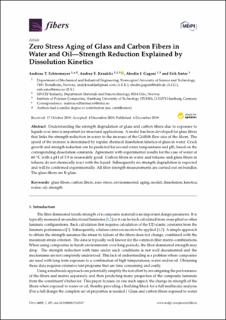| dc.contributor.author | Echtermeyer, Andreas | |
| dc.contributor.author | Krauklis, Andrey | |
| dc.contributor.author | Gagani, Abedin | |
| dc.contributor.author | Sæter, Erik | |
| dc.date.accessioned | 2020-11-10T13:01:34Z | |
| dc.date.available | 2020-11-10T13:01:34Z | |
| dc.date.created | 2020-01-16T12:39:34Z | |
| dc.date.issued | 2019 | |
| dc.identifier.citation | Fibers. 2019, 7 (12), 107-?. | en_US |
| dc.identifier.issn | 2079-6439 | |
| dc.identifier.uri | https://hdl.handle.net/11250/2687129 | |
| dc.description.abstract | Understanding the strength degradation of glass and carbon fibers due to exposure to liquids over time is important for structural applications. A model has been developed for glass fibers that links the strength reduction in water to the increase of the Griffith flaw size of the fibers. The speed of the increase is determined by regular chemical dissolution kinetics of glass in water. Crack growth and strength reduction can be predicted for several water temperatures and pH, based on the corresponding dissolution constants. Agreement with experimental results for the case of water at 60 °C with a pH of 5.8 is reasonably good. Carbon fibers in water and toluene and glass fibers in toluene do not chemically react with the liquid. Subsequently no strength degradation is expected and will be confirmed experimentally. All fiber strength measurements are carried out on bundles. The glass fibers are R-glass. | en_US |
| dc.language.iso | eng | en_US |
| dc.publisher | MDPI | en_US |
| dc.rights | Navngivelse 4.0 Internasjonal | * |
| dc.rights.uri | http://creativecommons.org/licenses/by/4.0/deed.no | * |
| dc.subject | strength | en_US |
| dc.subject | Oil | en_US |
| dc.subject | kinetics | en_US |
| dc.subject | water | en_US |
| dc.subject | dissolution | en_US |
| dc.subject | zero stress | en_US |
| dc.subject | carbon fibers | en_US |
| dc.subject | glass fibers | en_US |
| dc.subject | environmental | en_US |
| dc.title | Zero Stress Aging of Glass and Carbon Fibers in Water and Oil—Strength Reduction Explained by Dissolution Kinetics | en_US |
| dc.type | Peer reviewed | en_US |
| dc.type | Journal article | en_US |
| dc.description.version | publishedVersion | en_US |
| dc.rights.holder | © 2019 by the authors. Licensee MDPI, Basel, Switzerland. This article is an open access article distributed under the terms and conditions of the Creative Commons Attribution (CC BY) license (http://creativecommons.org/licenses/by/4.0/). | en_US |
| dc.source.pagenumber | 14 | en_US |
| dc.source.volume | 7 | en_US |
| dc.source.journal | Fibers | en_US |
| dc.source.issue | 12 | en_US |
| dc.identifier.doi | 10.3390/fib7120107 | |
| dc.identifier.cristin | 1774748 | |
| dc.relation.project | Norges forskningsråd: 245606 | en_US |
| dc.source.articlenumber | 107 | en_US |
| cristin.unitcode | 7401,80,0,0 | |
| cristin.unitname | SINTEF Industri | |
| cristin.ispublished | true | |
| cristin.fulltext | original | |
| cristin.qualitycode | 1 | |

